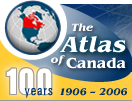| This map shows the location of major groundwater
resources in Canada. As it is difficult to express the importance
and nature of groundwater resources on a small-scale map, the text
below describes the general nature of groundwater, and then describes
locations in Canada where groundwater is particularly important.
The Nature of Groundwater
Groundwater is water found beneath the earth's
surface and located at the water table and below. Groundwater is
frequently concentrated in large subterranean areas called aquifers.
(An aquifer is an underground formation
of permeable rock or loose material which can produce useful quantities
of water when tapped by a well).
 [D] [D]
Click for larger version, 19 KB
Figure 1. Diagram of the Groundwater System
The large majority of the world's liquid freshwater is found underground.
Even in Canada, there is more water underground than on the surface.
This water is found in aquifers and appears at the surface as springs.
Groundwater occurs in the tiny spaces between loose materials on
top of the bedrock, or in cracks in bedrock. These cracks hold water
in the same way a sponge holds water. The most important concentrations
are in aquifers, in particular, near the top level of aquifers (the
water table). The natural connections of groundwater to the surface
are varied: groundwater is interconnected with lakes and rivers,
and it often also emerges naturally as springs.
Groundwater Locations
The map depicts the Canadian distribution of aquifers of sufficient
extent and water volume for most domestic and industrial uses. The
origin and composition of aquifers is varied, as are their uses.
Some important examples are given below.
- Many important Canadian aquifers are composed of thick deposits
of sand and gravel previously laid down by glacial rivers. These
types of aquifers provide most of the water supply for some large
municipalities including the Kitchener-Waterloo region in Ontario
and the Fredericton area in New Brunswick. The Carberry aquifer
in Manitoba, west of Winnipeg, is an old delta lying on what was
formerly glacial Lake Agassiz. This aquifer is well developed
as a source of irrigation water.
- Prince Edward Island depends on sandstone aquifers for its entire
water supply.
- A major glacial outwash sand and gravel aquifer occurs in the
lower Fraser Valley in British Columbia. It is extensively used
for municipal, domestic, and industrial water supplies.
- The Winnipeg and Montréal aquifers, both of which are
used for industrial water supply, are composed of fractured rocks.
Many individual farms and rural homes across Canada depend on other
small aquifers such as thin sand and gravel deposits of glacial
or other origin. Although these aquifers are individually not very
significant, in total they make up a very important groundwater
resource. Generally speaking, areas of poorest aquifer extent correspond
to the Canadian Shield - the Precambrian rocks that underlie half
of Canada. Not only are the Shield's rock types poor for storing
water (they are usually igneous or metamorphic), but most of the
Shield also has thin or non-existent land cover and so has few areas
with a water table.
Importance of Groundwater
The most significant ecological function of groundwater is its
gradual discharge to rivers to maintain streamflow during dry weather
periods throughout the year.
Groundwater is also extremely important in supplying fresh water
for Canadians. About eight million people, or 26% of the population,
depend on groundwater. Approximately two-thirds, or five million,
of these users live in rural areas. Figure 2 shows the proportion
of the population in each province and territory dependent on groundwater
for municipal, domestic and rural use. Other than in some of the
territories, there is always at least one-fifth of the population
in every province dependent on groundwater. The provinces which
have relatively high rural populations, such as Saskatchewan and
the Atlantic Provinces, have much higher reliancy percentages on
groundwater resources.
 [D] [D]
Click for larger version, 48 KB
Figure 2. Percentage of the Population Reliant on Groundwater
As well as supplying basic human needs, groundwater is also used
for livestock watering, irrigation, aquaculture (fish farms), and
mineral and hydrocarbon extraction.
In addition to the direct use of groundwater for human needs, bottled
groundwater, known as "spring water" or "mineral
water", is being purchased by many Canadians to replace drinking
water that flows through their taps, particularly in the areas close
to Lake Ontario and the St. Lawrence River.
Groundwater can even serve as a source of energy. Ground source
heat pumps are receiving increased attention as energy efficient
commercial and residential heating and cooling systems. As well,
the use of geothermal water is the subject of ongoing research and
several heating and/or cooling projects for facilities such as a
public swimming pools, recreational facilities and for Carleton
University in Ottawa.
Groundwater Contaminants
Groundwater contaminants come from two categories of sources:
- point sources such as landfills, leaking gasoline storage tanks,
industrial sources, and accidental spills. Among the more significant
point sources are municipal landfills and industrial waste disposal
sites. When either of these occur in or near sand and gravel aquifers,
the potential for widespread contamination is the greatest
- distributed (non-point) sources such as infiltration from farmland
treated with pesticides
|
